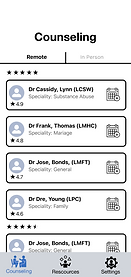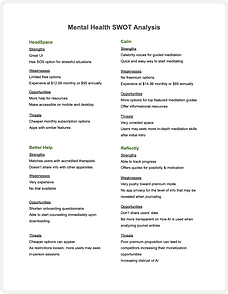







Problem
Military veterans are not easily able to quickly understand their mental health benefits or be able to sign up for services. Without accessing these health benefits, millions of veterans with mental health issues go untreated and this impacts all aspects of their lives.
Process
This project, I used Design Thinking to approach all problems from a user centered perspective. This process helped to gain a better understanding of user problems and the workflow is highly compatible with agile teams.
Design Roles
Ideation & Concept
Research
Information Architecture
Visual Design
User Testing
Tools
Figma
Google Forms
Adobe Creative Cloud
Notion
Deliverables
User Interviews & Survey
Competitive Analysis
User Personas
User Stories & Flows
Wireframes
High-Fidelity Mockups
Usability Tests
Secondary Market Research
Utilizing research conducted by the National Academies of Sciences on the Department of Veterans Affairs Mental Health Services, I discovered the market’s demographics and was able to convert user responses into behavioral personas.

N = 4,180
Reasons Not Using Mental Health Services
-
Does not know how to apply for mental health care
-
Does not believe eligible for VA mental health benefits
-
Not aware VA offers mental health care benefits
-
Does not trust the VA
-
Had a prior bad experience at VA
Perceived Obstacles to Using Services
-
Could be denied security clearance in the future
-
Mental health care would cost to much
-
Would be seen weak by others
-
Could harm their career
-
Others would have less confidence in them
Importance of Select Changes the VA could make
-
Easy appointment process
-
Better quality service
-
Better customer service
-
More available services
-
Closer facilities
User Research
User Research
-
90% of respondents have struggled with mental health
-
83% sought out help
-
Of those, 29% were unsatisfied with their experience



Combining data from user surveys, user interviews, and an expert interview; the users’ needs and frustrations were added to the user personas. This gave more clarity into the specific problems the project would solve.
Needs
-
Find an outlet to calm mind
-
Quick and easy sign in process
-
Privacy and safety
-
Learn coping skills
-
Diagnosis and treatment
-
Multiple methods to meet with counselors
Frustrations
-
No guidance after the counseling session
-
Hard to enroll into VA health services
-
Counselors that aren't up to standards
-
Impersonal counselors
-
Lack of resources
-
Long wait times
User Personas
After analyzing the data, behavioral personas were made to represent the users needs and frustrations. They were vital when making user-centric decisions.

The Do it Yourselfer
Motivation
Wants help but is concerned with the possible negative outcomes of sharing innermost thoughts
Needs
Self-help techniques to practice
Services available 24/7
Knowing info is private and secure
Frustrations
Doesn't want private info being seen, shared, or sold
Mental health stigma concerns

The Connector
Motivation
Develop cooperation & coping skills
Needs
Someone to talk to
Sense of community
Resources between counseling sessions
Frustrations
Lack of human connection
Answering assessments rather than engaging in conversation

Frustrated Vet
Motivation
Outlet for negative feelings
Needs
Easy appointment scheduling
Services available nearby
Quality & trusted services
Frustrations
Hard to enroll into VA health services
Counselors that aren't up to personal standards
Headspace - meditation and sleep (4.9 App Store rating)

Calm - meditation and sleep (4.8)


Better Help - 24/7 professional therapy (4.7)
Reflectly - mood tracker and daily quotes (4.6)


From the feature offerings; privacy and therapy would give biggest competitive differential from the competitors.
Business Requirements
-
Don’t share personally identifying information
-
Offers counseling
-
Quick and easy onboarding/scheduling
User Requirements
-
Be transparent on how you keep their data private and secure
-
Offer resources (meditation and info) to be used between sessions
-
Desktop option for counseling sessions
-
Instill trust
Then the digital wireframes were created in Figma. The components were placed properly by following the Human Interface Guidelines.






Usability Testing
The digital wireframes were connected with Figma to establish logical pathways between them.
Tasks
Log in
Schedule a remote counseling session
Enter counseling session
Schedule an in-person counseling session
View in-person session info
Open a resource course
Notable Changes & Comments
Add option to share location for entering address
Map should show indicators of destinations
Add a text option to audio resources
"I like the calendar - Its similar to Calendly"
"I like the balanced interface"
"I can quickly get to where I want"
Brand Identity
For typography, Apple’s SF Pro fonts were paired. This sans-serif provides a consistent, legible and friendly typographic voice. This works well with the brand’s voice of friendly and professional.

Next, using color theory, I decided on a color scheme that is welcoming and pleasant.
HEX
RGB-A/CSS
HSB
Theory
76C38F
118, 195, 143, 1
139, 39, 76, 100%
Peaceful & Health
76C38F
118, 195, 143, 1
139, 39, 76, 100%
Peaceful & Health
HEX
RGB-A/CSS
HSB
Theory
5086EC
80, 134, 236, 1
219, 66, 93, 100%
Trust & Dependable
HEX
RGB-A/CSS
HSB
Theory
5B5B5B
91, 91, 91, 1
0, 0, 36, 100%
Balance & Calm
HEX
RGB-A/CSS
HSB
Theory
B9E0C5
185, 224, 197, 1
138, 17, 88, 100%
Peaceful & Health
HEX
RGB-A/CSS
HSB
Theory
C4D7FD
196, 215, 253, 1
220, 23, 99, 100%
Trust & Dependable
HEX
RGB-A/CSS
HSB
Theory
FF8E8E
255, 142, 142, 1
0, 44, 100, 100%
Warning & Urgency
Preference Testing
To establish the logo, I conducted a round of a/b tests to distinguish clarity and preference among options.

Onboarding
Schedule Session





Use a Resource







Lesson Learned...
The value of user interviews and how they helped understanding multiple perspectives on mental health more in-depth. This led to identifying additional mental health solutions.
Even while sketching and wireframing, focus on only the core requirements when building a map to save time on designing features, that will not be initially built.
Check for user preferences on device usage. Prior to surveying I would have assumed that users preferred connecting with counselors through their mobile device; however, the results suggested that they wanted desktop for therapy sessions. This finding led to a high priority of making a desktop portal for meeting with counselors.
After the initial target market of military and veterans, there is a huge opportunity in the vast meditation app landscape for users that do not want to be personally tracked throughout other apps and websites.







